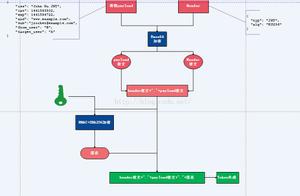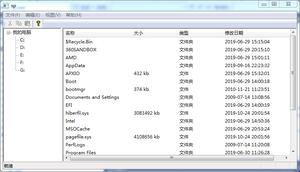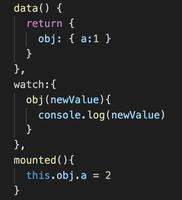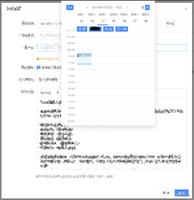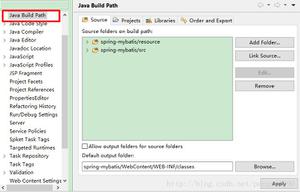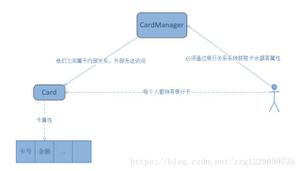React直出实现与原理

前一篇文章我们介绍了虚拟DOM的实现与原理,这篇文章我们来讲讲React的直出。 比起MVVM,React比较容易实现直出,那么React的直出是如何实现,有什么值得我们学习的呢?
为什么MVVM不能做直出?
对于MVVM,HTML片段即为配置,而直出后的HTML无法还原配置,所以问题不是MVVM能否直出,而是在于直出后的片段能否还原原来的配置。下面是一个简单的例子:
<sapn>Hello {name}!</span>上面这段HTML配置和数据在一起,直出后会变成:
<span>Hello world!</span>这时候当我们失去了name的值改变的时候会导致页面渲染这个细节。当然,如果为了实现MVVM直出我们可能有另外的方法来解决,例如直出结果变成这样:
<span>Hello <span q-text="name">world</span>!</span>这时候我们是可以把丢失的信息找回来的,当然结构可能和我们想象的有些差别。当然还有其他问题,例如直出HTML不一定能反向还原数据,由于篇幅问题,这里不展开讨论。
React如何直出?
如图:
- React的虚拟DOM的生成是可以在任何支持Javascript的环境生成的,所以可以在NodeJS或Iojs环境生成
- 虚拟DOM可以直接转成String
- 然后插入到html文件中输出给浏览器便可
具体例子可以参考,https://github.com/DavidWells/isomorphic-react-example/,下面是其渲染路由的写法:
// https://github.com/DavidWells/isomorphic-react-example/blob/master/app/routes/coreRoutes.jsvar React = require('react/addons');
var ReactApp = React.createFactory(require('../components/ReactApp').ReactApp);
module.exports = function(app) {
app.get('/', function(req, res){
// React.renderToString takes your component
// and generates the markup
var reactHtml = React.renderToString(ReactApp({}));
// Output html rendered by react
// console.log(myAppHtml);
res.render('index.ejs', {reactOutput: reactHtml});
});
};
OK,我们现在知道如何利用React实现直出,以及如何前后端代码复用。
但还有下面几个问题有待解决:
- 如何渲染文字节点,每个虚拟DOM节点是需要对应实际的节点,但无法通过html文件生成相邻的Text Node,例如下面例子应当如何渲染:
React.createClass({ render: function () {
return (
<p>
Hello {name}!
</p>
);
}
})
- 如何避免直出的页面被React重新渲染一遍?或者直出的页面和前端的数据是不对应的怎么办?
相邻的Text Node,想多了相邻的span而已
通过一个简单的例子,我们可以发现,实际上React根本没用Text Node,而是使用span来代替Text Node,这样就可以实现虚拟DOM和直出DOM的一一映射关系。
重复渲染?没门
刚刚的例子,如果我们通过React.renderToString拿到<Test />可以发现是:
<p data-react>!</span></p>我们可以发现一个有趣的属性data-react-checksum,这是啥?实际上这是上面这段HTML片段的adler32算法值。实际上调用React.render(<MyComponent />, container);时候做了下面一些事情:
- 看看container是否为空,不为空则认为有可能是直出了结果。
- 接下来第一个元素是否有
data-react-checksum属性,如果有则通过React.renderToString拿到前端的,通过adler32算法得到的值和data-react-checksum对比,如果一致则表示,无需渲染,否则重新渲染,下面是adler32算法实现:
var MOD = 65521;// This is a clean-room implementation of adler32 designed for detecting
// if markup is not what we expect it to be. It does not need to be
// cryptographically span, only reasonably good at detecting if markup
// generated on the server is different than that on the client.
function adler32(data) {
var a = 1;
var b = 0;
for (var i = 0; i < data.length; i++) {
a = (a + data.charCodeAt(i)) % MOD;
b = (b + a) % MOD;
}
return a | (b << 16);
}
- 如果需要重新渲染,先通过下面简单的差异算法找到差异在哪里,打印出错误:
/** * Finds the index of the first character
* that's not common between the two given strings.
*
* @return {number} the index of the character where the strings diverge
*/
function firstDifferenceIndex(string1, string2) {
var minLen = Math.min(string1.length, string2.length);
for (var i = 0; i < minLen; i++) {
if (string1.charAt(i) !== string2.charAt(i)) {
return i;
}
}
return string1.length === string2.length ? -1 : minLen;
}
下面是首屏渲染时的主要逻辑,可以发现React对首屏实际上也是通过innerHTML来渲染的:
_mountImageIntoNode: function(markup, container, shouldReuseMarkup) { ("production" !== process.env.NODE_ENV ? invariant(
container && (
(container.nodeType === ELEMENT_NODE_TYPE || container.nodeType === DOC_NODE_TYPE)
),
'mountComponentIntoNode(...): Target container is not valid.'
) : invariant(container && (
(container.nodeType === ELEMENT_NODE_TYPE || container.nodeType === DOC_NODE_TYPE)
)));
if (shouldReuseMarkup) {
var rootElement = getReactRootElementInContainer(container);
if (ReactMarkupChecksum.canReuseMarkup(markup, rootElement)) {
return;
} else {
var checksum = rootElement.getAttribute(
ReactMarkupChecksum.CHECKSUM_ATTR_NAME
);
rootElement.removeAttribute(ReactMarkupChecksum.CHECKSUM_ATTR_NAME);
var rootMarkup = rootElement.outerHTML;
rootElement.setAttribute(
ReactMarkupChecksum.CHECKSUM_ATTR_NAME,
checksum
);
var diffIndex = firstDifferenceIndex(markup, rootMarkup);
var difference = ' (client) ' +
markup.substring(diffIndex - 20, diffIndex + 20) +
'\n (server) ' + rootMarkup.substring(diffIndex - 20, diffIndex + 20);
("production" !== process.env.NODE_ENV ? invariant(
container.nodeType !== DOC_NODE_TYPE,
'You\'re trying to render a component to the document using ' +
'server rendering but the checksum was invalid. This usually ' +
'means you rendered a different component type or props on ' +
'the client from the one on the server, or your render() ' +
'methods are impure. React cannot handle this case due to ' +
'cross-browser quirks by rendering at the document root. You ' +
'should look for environment dependent code in your components ' +
'and ensure the props are the same client and server side:\n%s',
difference
) : invariant(container.nodeType !== DOC_NODE_TYPE));
if ("production" !== process.env.NODE_ENV) {
("production" !== process.env.NODE_ENV ? warning(
false,
'React attempted to reuse markup in a container but the ' +
'checksum was invalid. This generally means that you are ' +
'using server rendering and the markup generated on the ' +
'server was not what the client was expecting. React injected ' +
'new markup to compensate which works but you have lost many ' +
'of the benefits of server rendering. Instead, figure out ' +
'why the markup being generated is different on the client ' +
'or server:\n%s',
difference
) : null);
}
}
}
("production" !== process.env.NODE_ENV ? invariant(
container.nodeType !== DOC_NODE_TYPE,
'You\'re trying to render a component to the document but ' +
'you didn\'t use server rendering. We can\'t do this ' +
'without using server rendering due to cross-browser quirks. ' +
'See React.renderToString() for server rendering.'
) : invariant(container.nodeType !== DOC_NODE_TYPE));
setInnerHTML(container, markup);
}
最后
尝试一下下面的代码,想想React为啥认为这是错误的?
var Test = React.createClass({ getInitialState: function() {
return {name: 'world'};
},
render: function() {
return (
<p>Hello</p>
<p>
Hello {this.state.name}!
</p>
);
}
});
React.render(
<Test />,
document.getElementById('content')
);
以上是 React直出实现与原理 的全部内容, 来源链接: utcz.com/z/381750.html

